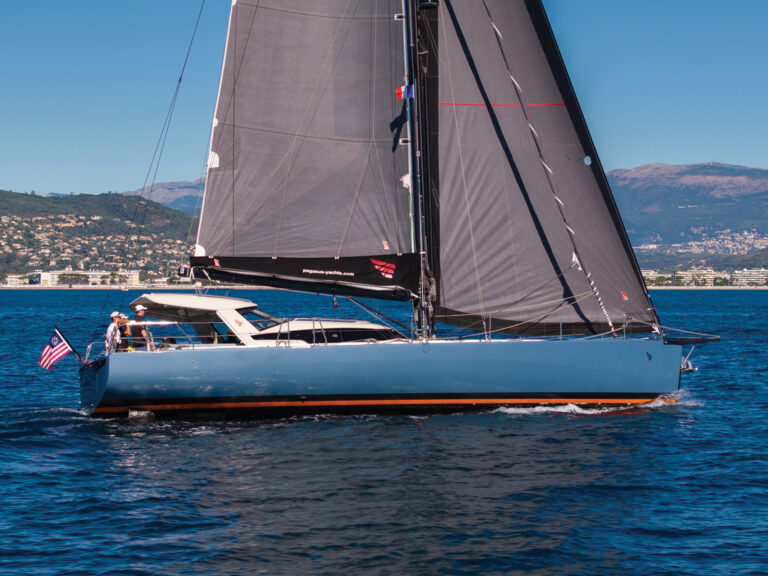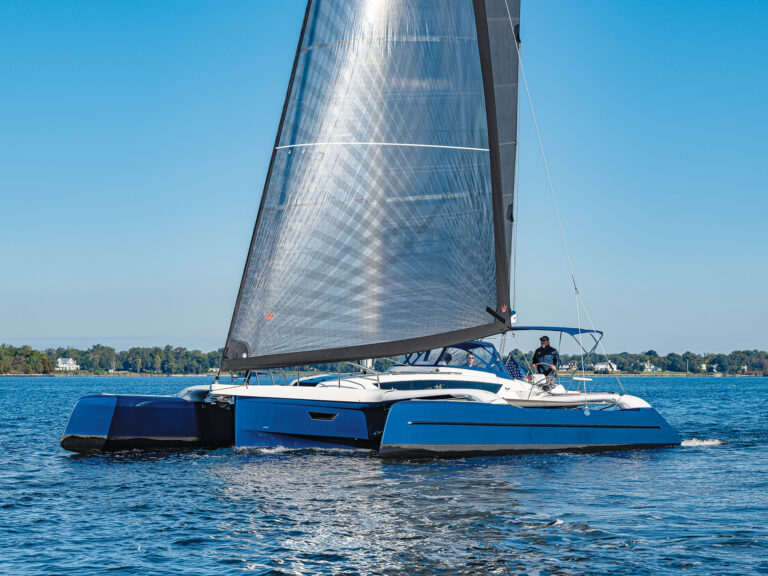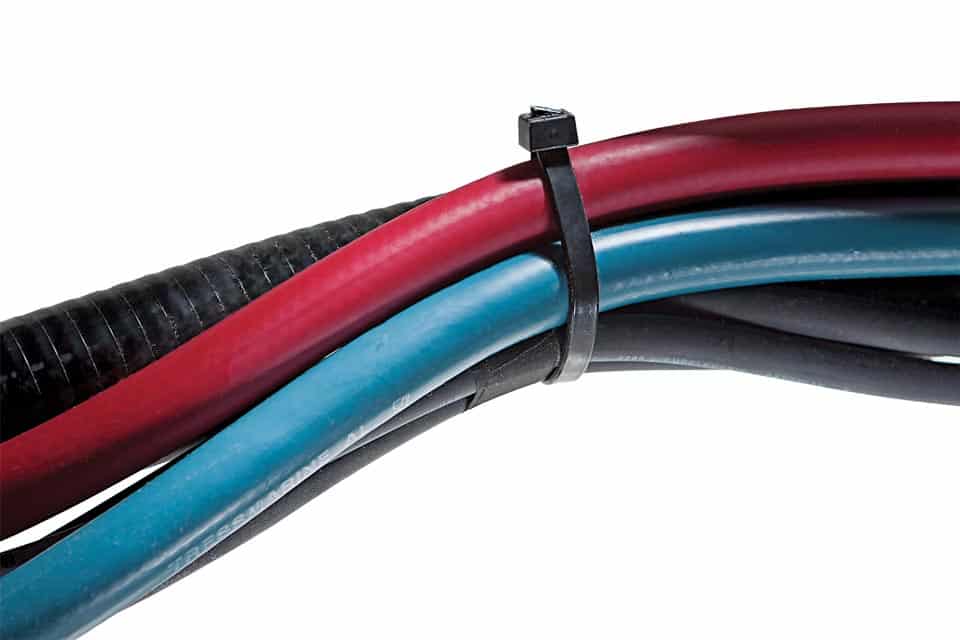
crw0913_systemmarinehoses_01.jpg
Marine plumbing hose, depending on where it’s used, must successfully withstand vacuum pressure, handle a wide temperature range, contain poisonous gases and odors, and do all of this without sinking the boat. No matter what the hose is being used for, the main thing to remember is that marine plumbing is no place to trade quality for cheaper materials. The boat’s entire value depends on what happens just inboard of its through-hull fittings. Good hose — hose that can stand up to pressure, heat and chemicals — is a critical boatbuilding component. Is the boat seaworthy? One part of the answer comes directly from the quality of its hose.
Standards and ratings for marine hose come from a patchwork of sources, including the U.S. Coast Guard, the U.S. Food and Drug Administration, the International Standards Organization, the Society of Mechanical Engineers, Underwriters Laboratories and others. Two things to keep in mind: Only use hose supplied by a reputable manufacturer, and make sure the hose is clearly labeled for its intended use.
The layout of hose in a marine plumbing system is as important as the material itself. In electrical systems, we encounter resistance and voltage drop based on the diameter and layout of conduits. Same goes for hose. Every foot of hose adds measurable resistance to a marine plumbing system. If you read in a manufacturer’s specs that a pump is rated for 30 gallons per minute, understand that this figure may be based on ideal conditions — which almost never exist in real installations.
That’s because there’s one important difference between wire runs in electrical systems and hose runs in plumbing: gravity. If you were to stack 10 cubes of water on top of each other — each of which was one cubic foot — the weight at the bottom of the stack would be a whopping 624 pounds. Understand that every uphill run of hose adds tremendous resistance to the system, requiring more power to act on pump handles and diminishing the pump’s output. Some pumps are rated for maximum “lift” — the greatest height they can pump a column of water and still keep pumping. “Head” refers to the pressure exerted by the weight of a liquid in a vertical column. If a boatbuilder or boat owner installs a pump based on its rated capacity in ideal conditions, forgetting head pressure and lift, you can bet the pump is undersized for the job. Designing intelligent hose runs can help a lot.
Attaching marine hose to plumbing fittings presents some challenges. Hose is measured according to its inside diameter, usually available in increments of ¼ inch or ⅛ inch. But solid pipe or tubing is typically measured according to its outside diameter. Though it’s sometimes tricky, the key is to get a good, snug fit with a plumbing adapter — say, a barb fitting. Some standards call for two hose clamps for all installations below the waterline, but make sure the plumbing fitting is long enough to support both hose clamps. Don’t ever install a clamp over hose that isn’t supported by a fitting; doing so could damage the hose and end up being worse than installing only one. Also make sure that the hose clamps you use are made entirely from stainless steel — that means the threads as well as the band — and that they’re sized for the diameter of hose that you’re using. If bands are too long, they’ll leave sharp tails that will surely draw blood when you or someone else goes reaching into dark corners.
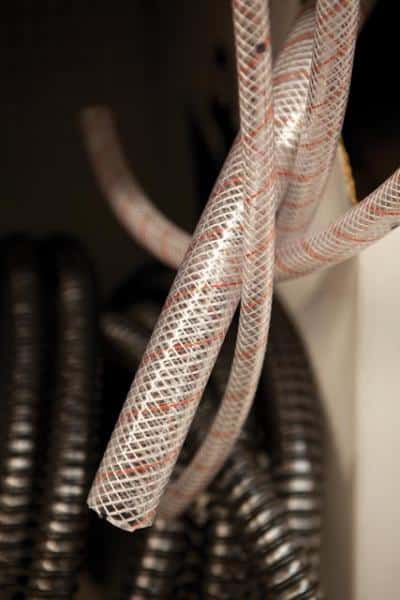
| |Polyester-reinforced clear PVC hose is commonly used for potable water systems; however, since light can penetrate it, algae growth may be a problem.|
With the goal of leakproof snugness, actually getting the hose onto the fitting can be tricky. One tip is to dip the end of the hose in hot water to soften the material, or to use a heat gun or hair drier; just don’t go too far with the heat. If the hose is wire-reinforced to withstand vacuum pressure, it can be especially tricky to fit in place. One tip here is to cut the hose to length, grasp the reinforcing wire with pliers, pull it out as far as you can, then snip it with wire cutters. The wire should draw back up into the hose, and you’ll have more flexible material to work with at the end of the hose.
Hose for Potable Water
Potable water is basically water you can drink. In legal terms, it’s defined as water that meets the drinking-water standards set by the U.S. Public Health Service. In practice, potable water systems supply galleys, heads, sinks and showers. These are sometimes called domestic water systems.
The main duty of hose for potable water is to deliver drinking water without introducing any taste, odor or color along the way. Clear polyvinyl chloride (PVC) has long been used in this function. The drawback is that clear PVC allows sunlight to penetrate inside, which encourages algae to grow in the water. For that reason, some experts recommend hard plastic or copper pipe, or opaque tubing. Potable water hose that’s color-coded blue (cold) and red (hot) is also a good choice.
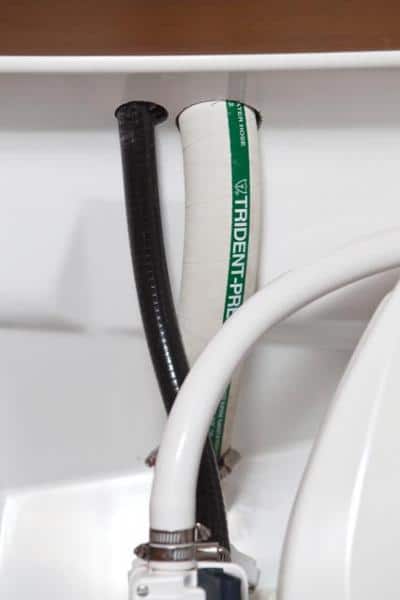
| |High-quality sanitation hose (with green stripe) has wire reinforcement and thick two-ply construction to provide abrasion resistance and prohibit odor permeation. |
Sanitation Hose
Nothing kills a good day on the water like the smell of raw sewage. Containing odors is the second most important job sanitation hose has to master, after simply containing effluent. A black rubber compound called ethylene propylene diene monomer, or EPDM, does this job well. So does styrene butadiene rubber, or SBR. Even if you don’t commit the names of those materials to memory, just appreciate the difference between good-quality hose and cheap substitutes. Permeable materials let gas or liquids pass through; impermeable materials prevent this. For sanitation hose, impermeability is definitely the trait we’re looking for. Make sure the hose you use is labeled “sanitation hose” and that it comes from a reputable supplier.
After choosing material, we also have to ensure good design in the layout of the hose — avoiding dips in the hose run, for example, where sewage can collect. Ideally, that means an unhindered downhill run on the discharge side from the vented loop to the holding tank or through-hull fitting. Speaking of the vented loop, make sure the vent itself is plumbed outboard for odors — and use sanitation hose for this vent line too.
Hose for Bilge Pumps
While no standard exists for bilge-pump hoses per se, there are a few guidelines to keep in mind. For one thing, make sure that its diameter is equal to the output of the bilge pump. If it’s smaller, it will severely diminish the pump’s output. The hose run should be as short and as straight as it can be. Hose length and hose bends both add tremendous resistance to a plumbing system. Avoid corrugated hose. While corrugated hose is simple to install because it’s simple to bend, the ridges can trap the debris that inevitably collects in a bilge. Make sure that the hose material can stand up to anything that might end up in the bilge. Never forget that bilges are by definition nasty places. Fluids that you never planned for — engine coolant, say, or hot water, or worse — might very well end up in the bilge someday, so choose a hose with a heavy-duty, reinforced construction. The bilge-pump hose needs to be able to carry whatever comes along.
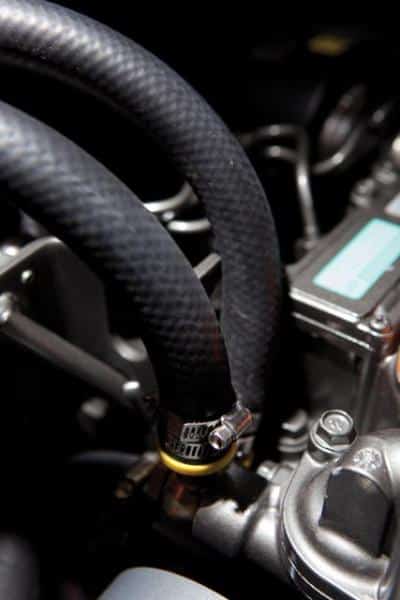
| |Heavy-duty reinforced hose is used on the intake side of a raw-water cooled engine. It only needs to withstand vacuum pressure without collapsing. On the exhaust side, the hose needs to handle high temperatures and meet SAE J2006 standards.|
Hose for Engine Cooling
The engine-cooling system is a dedicated plumbing system that’s independent of the domestic plumbing. It takes seawater from outside the boat, circulates it either through the engine itself (a raw-water-cooled system) or through a heat exchanger (a freshwater-cooled system), and then pumps hot exhaust water overboard with the engine’s exhaust gases. The water pump that drives this circulation is typically an engine-mounted impeller pump; the rotation of the running engine drives the pump.
On the intake side — from the boat’s through-hull fitting to the water pump — the hose you use needs to withstand vacuum pressure. Subject to suction, it must not collapse. Heat on this side of the system is not a concern. Reinforced hose is the right choice.
On the discharge side, a typical installation for an inboard engine is what’s called “wet exhaust.” In this scenario, seawater that has circulated through either the engine or the heat exchanger passes through a mixing elbow at the engine’s exhaust manifold. Here, the cooling water mixes with exhaust gases from the engine’s cylinders. Wet exhaust systems have the advantage of being quieter, cleaner and cooler than those that deal separately with exhaust and the discharge water. But it also means the hose needs to be impermeable and heat-resistant. American Boat and Yacht Council Standards call for hose that meets the requirements of SAE J2006 or UL 1129 from the connection at the exhaust manifold to the overboard discharge fitting.
Winterizing Marine Plumbing Systems
Marine hoses can be fragile when it comes to withstanding pressure, temperature and chemicals. That’s why it’s critical to take special care of them when boats are laid up for the winter in climates that freeze. The best thing to do before winter is to rid the various plumbing systems of water. That means draining potable-water tanks, if possible.
If you’re going to use antifreeze, understand what you’re using. There are two basic kinds: one poisonous, the other nontoxic. Ethylene glycol is poisonous; this is the kind that’s typically used on the closed side of engine-cooling systems. For potable-water systems, you need to use propylene glycol, which is both nontoxic and ecologically friendly. This should also be used for sanitation systems and any system where overboard discharge may occur. Beware, though, that propylene glycol can harm PVC sanitation hose.
Cruising World editor-at-large Tim Murphy is the co-author of Fundamentals of Marine Service Technology (ABYC, 2012), from which this article is excerpted. He sails Ave Marina, a Vineyard Vixen 29, in and around Rhode Island’s Narragansett Bay.





